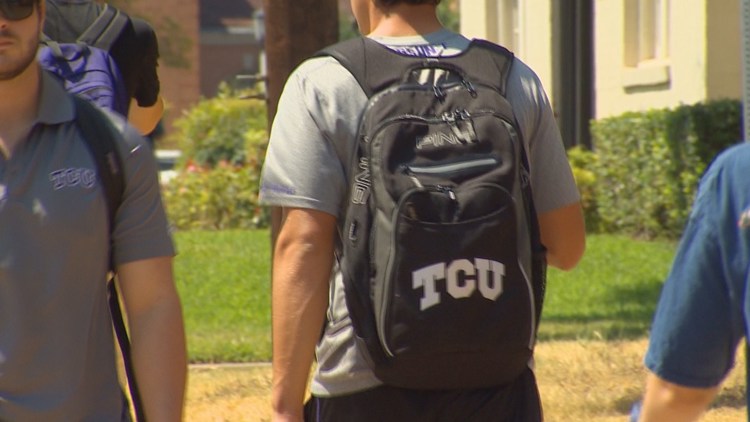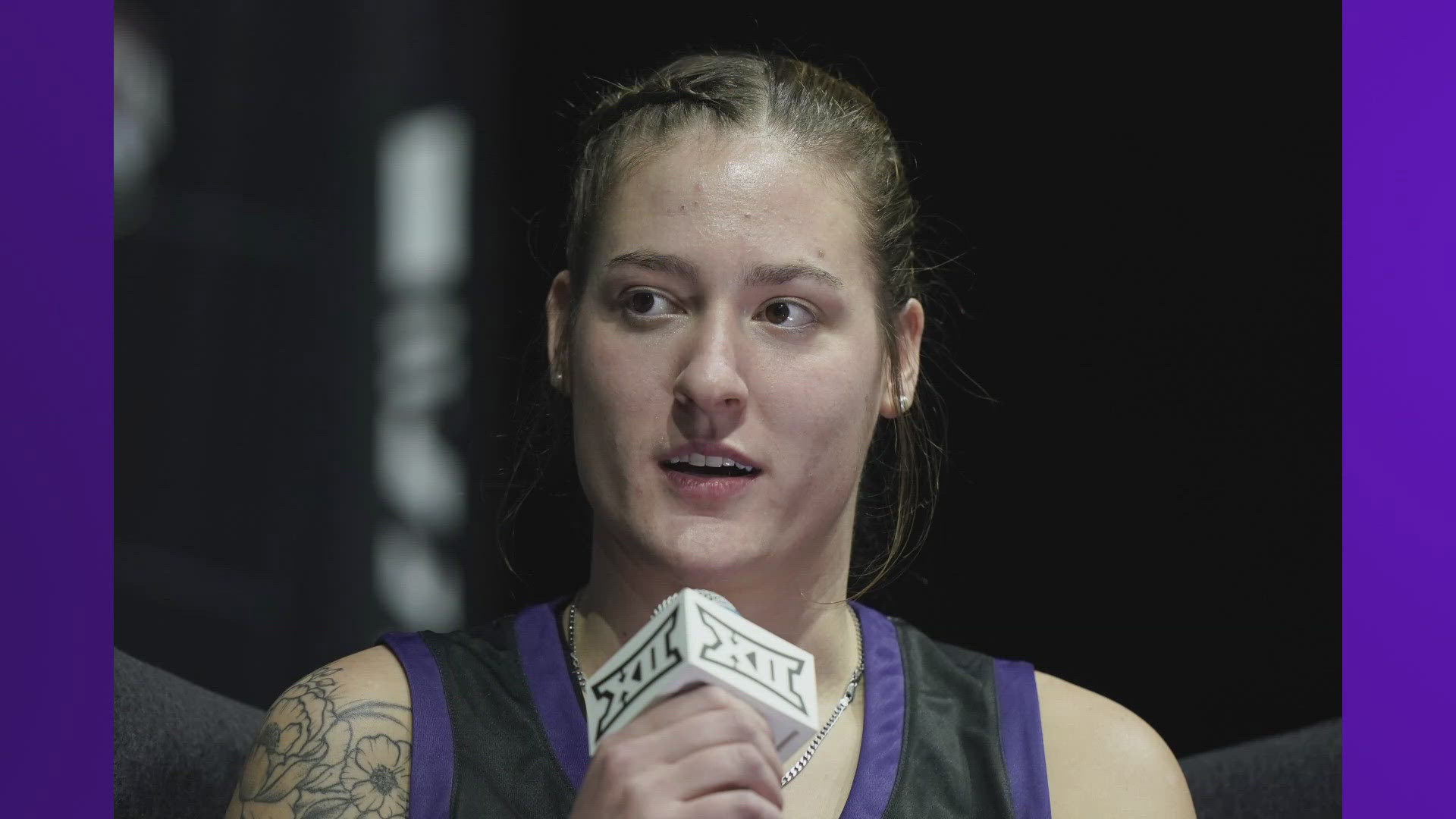FORT WORTH, Texas — This article was originally published by our content partners at the Texas Tribune. Read the original article here.
It’s practically in Ben Beland’s genes to be a Razorback. His parents, both sets of grandparents, all of his great-grandparents and sister went to the University of Arkansas. His brother-in-law even played tight end for Arkansas.
Since he was 5 years old, Beland thought he would follow in his family’s footsteps. When college decision time came more than a year ago, though, Beland chose TCU.
“It’s so funny how fast purple became their favorite color,” said Beland, talking about how his parents embraced his decision to go to TCU after they visited the campus on spring break. “The second I committed to come to the school, they started buying TCU shirts, TCU stickers and a wardrobe. It went from Razorback Red to Horned Frog Purple pretty fast.”
Beland, a sophomore from Fort Smith, Arkansas, isn’t in the minority, at least when the population is defined by out-of-state enrollment. TCU, which has long been a Fort Worth institution with a proud and deep alumni base in the city, has been growing its out-of-state enrollment. Beginning in 2018, the percentage of out-of-state students going to TCU eclipsed the percentage of in-state students, and enrollment hasn’t looked back since. In 2023, the percentage of out-of-state students attending the private university was 52%, according to institutional data on TCU’s website.
California is, by far, the state contributing the largest number of out-of-state students to TCU’s tally. Since 2014, more than 1,000 students have arrived from California. In 2023, of the university’s nearly 11,000 students, around 1,500 were from the Golden State — more than double the number in 2012. Other states with significant numbers of students drawn to the purple and white include Illinois, Colorado, Missouri and Minnesota.
“We graduated to the Big 12 Conference in the summer of 2012, and that just puts more eyeballs onto your university. But I don’t think it’s limited to only that,” said Heath Einstein, vice provost for enrollment management. “People talk, and that’s great. That’s how you build reputation.”
With signature moments in college athletics, applications to TCU see a spike, Einstein said. But then, rather than decline or plateau in the next year, the numbers continue to rise. For instance, when TCU won the Rose Bowl in 2011, applications during the next academic year spiked with 5,000 more applications. In 2012, applications continued to increase, said Einstein.
“The draw for TCU is this unique combination of qualities that we offer that almost no other college can offer,” he said. “We are offering this sort of small, intimate, close-connection kind of culture, without having to sacrifice big-time Division I athletics and all of the vibrancy that comes from that.”
Beland, who is double majoring in finance and accounting, wasn’t recruited to TCU. His mother, a high school English teacher, knew a couple of students who went to TCU and had nothing but good things to say. She told him to check out the school.
Football was a big draw for Beland, but it was also the school spirit — not just for sports but for the school itself — that drew him in. When Beland got a full-tuition Chancellor’s Scholarship to the university, his decision to become a Horned Frog was simple.
Private colleges across the state are increasing the percentage of out-of-state students they have. Rice University and Southern Methodist University have long had a majority of students come from out-of-state, in terms of the percentages for first-time undergraduates. But TCU is closing in on SMU; 43% of first-time undergraduates at TCU are in-state students, while SMU reports 38%.
Data used to compare universities comes from the National Center for Education Statistics, which uses a different data set — and shows different percentages — from those collected from TCU institutional data.
Robert Kelchen, a professor of higher education at the University of Tennessee at Knoxville, says that many universities, including TCU, are looking to broaden their pool of applicants who can pay close to full price.
“The why is revenue and prestige,” said Kelchen. “If they can tap into a market of really well-prepared, really wealthy students, they’re able to achieve both of those objectives.”
TCU’s total tuition for fall and spring semester is around $61,650, according to the university’s admissions website. Enrollment over the years has steadily increased, and a lot of that growth came from admitting more out-of-state students. In 2011, there were a total of 8,229 students. Last year, that number jumped to 10,915 — a 27% increase.
“We’re not targeting certain locations to be able to afford TCU. In fact, as the cost of tuition goes up, so too does the money that we put toward need-based financial aid and academic scholarships,” said Einstein, who has been working in enrollment management at TCU for more than a decade. “There’s no time where it’s more important for TCU to be accessible than right now.”
Financial aid has exploded, too. From 2011 to 2023, annual need-based aid given to students quadrupled, from $35 million to $142 million, while merit aid grew by nearly five times, from $22 million to $107 million, according to institutional data on TCU’s website.
Jaclynn Budreck, a senior allied health sciences major minoring in entrepreneurship and innovation, said her experience during COVID-19 affected her college choices. She was applying to college in the latter half of 2020, when much of her hometown of Chicago remained shut down. Attending college in Texas was a draw because she could attend in-person classes.
“Chicago is gray a good majority of the time,” said Budreck. “And then coming to school here, it was like Disney World, sunny every day. It kind of feels like a fever dream sometimes.”
The university has regional recruiters who live in or near Chicago and Atlanta as well as New England and northern and southern California. And it’s a lot of word-of-mouth that gets students to apply.
“You could go into any major region, and it will often come down to one or two or four or five high schools where we tend to draw from,” Einstein said, pointing to Darien High School in Connecticut, where one student’s arrival at TCU led to around a dozen students coming every year.
“Our goal is to continue to broaden that so it’s not only the same kinds of students who are coming here.”
While Orange County in the Los Angeles area is a huge wellspring for TCU students, Ava Faris didn’t know other students near her home that went to TCU. It was her sister’s co-workers in Dallas — most of whom were TCU graduates — who convinced her to apply.
“After I started talking to people who went to TCU, I saw that I hadn’t met a single person who could say anything bad about it,” said Faris, a senior who is double majoring in criminal justice and French. “The worst thing I heard was that the dining halls are not the greatest.”
She visited Texas for the first time when she came to tour the campus in the summer of 2020, during the pandemic. There were few students hanging around, but she fell in love with the campus.
“It wasn’t too big or too small,” said Faris, who listed TCU as one of her top five colleges. “And it was the right amount of distance from home to where I felt like I could be trying out something new.”
It’s a place where she could strike out on her own. Now, Faris will apply to law schools. Most of the schools on her list are in places that she already calls home: California and Texas.



